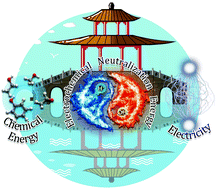Abstract
Aqueous electrochemical devices such as batteries and electrolytic cells have emerged as promising energy storage and conversion systems owing to their environmental friendliness, low cost, and high safety characteristics. However, grand challenges are faced to address some critical issues, including how to enhance the potential window and energy density of electrochemical power devices (e.g. fuel cells, batteries, and supercapacitors), and how to minimize the energy consumption in electrolysis. The use of decoupled acid–base asymmetric electrolytes shows great potential in improving the performance of aqueous devices by electrochemically converting the conventional thermal energy of acid–base neutralization into electricity, i.e., electrochemical neutralization energy (ENE). This review aims to introduce the little-known concept of the ENE, including its development history, thermodynamic fundamentals, operating principles, device configurations, and applications. The recent progress made in ENE-assisted electrochemical energy devices emphasizing fuel cells, batteries, supercapacitors, and electrolytic cells is summarized specifically. Finally, the challenges and future perspectives of ENE associated technology are discussed. It is believed that this tutorial review will give a better understanding of the mechanism and operating principles of the ENE to newcomers, which would shed light on the innovative design and fabrication of ENE-assisted devices and thus pave the way for the development of high-performance aqueous electrochemical energy devices.



 Please wait while we load your content...
Please wait while we load your content...